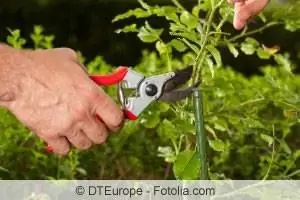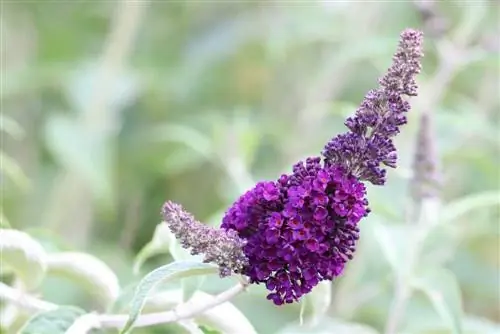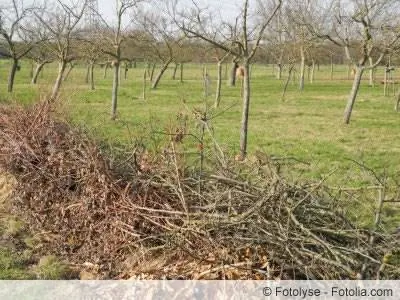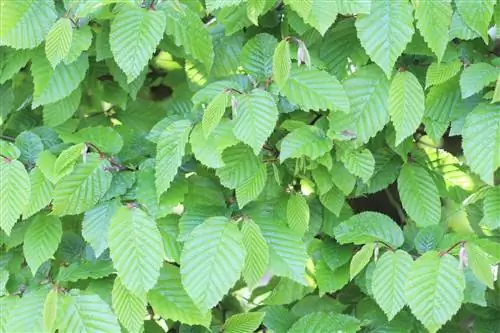- Author admin [email protected].
- Public 2023-12-17 03:39.
- Last modified 2025-06-01 06:48.
Dense growth, delicate flowers and intoxicating scent in summer alternate with bright rose hips from autumn to spring. As a protective niche for birds and a source of food in the cold season, there is always something going on in the wild rose hedge. It is also extremely easy to maintain and forgives the odd mistake. Nevertheless, some measures should not be missed when planting and cultivating so that the hedge can develop its full beauty.
Species
Wild roses, the origin of today's cultivated roses, can be found in different types. They usually grow densely, produce strongly scented flowers and require a minimum of care. For example, the following are suitable for hedge planting:
- Pike rose - Rosa glauca
- Multi-flowered rose - Rosa multiflora
- Scottish Fence Rose - Rosa rubiginosa
- Ellipse rose - Rosa elliptica
- Potato rose - Rosa rugosa
However, many of these species remain quite low and are therefore only partially suitable for privacy hedges. If you want to see the hedge grow beyond one and a half meters, use:
- Dog rose - Rosa canina
- Tufted rose - Rosa moyesii
- Dune rose, sand rose or beaver rose - Rosa carolina
Tip:
Since tall roses lack stability above a certain height, they should be offered climbing aid. This can be done in the form of a scaffold or through direct plant neighbors such as dogwood, rowan and barberry.
Location
The more sun the better - at least that applies to the location of the wild rose hedge. Only with sufficient light will the roses bloom vigorously and show their attractively dense growth, which is particularly desirable with a natural privacy screen.
The location for wild roses does not have to be particularly protected from wind and cold. Although the plants and their branches may look delicate, they are very robust and hardy. Nevertheless, a place that is too windy is unfavorable, especially for taller growing varieties without stabilizing climbing aid. In the long term, this could result in the shoots breaking or the hedge tipping over.
Substrate
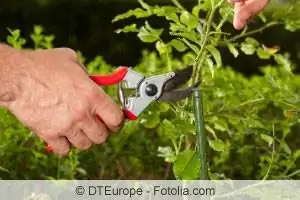
When it comes to the substrate, the requirements of the different types of roses differ at least slightly. The sand rose or meadow rose, as it is also called, prefers sandy soil with good drainage. However, it tolerates lime poorly.
The pike rose loves lime and prefers a fresh and nutrient-rich substrate. A general statement about the best soil for wild rose hedges is therefore not possible. Rather, decisions must be made based on the varieties chosen. However, this has the advantage that the rose types can be chosen to match the existing substrate.
Some general factors:
- Choose a loose substrate or loosen it up by digging and adding sand
- Preparation of nutrient-poor soils with compost or manure
- Avoid substrates that are prone to compaction or waterlogging or improve water drainage by mixing in sand
Planting
Planting the wild rose hedge is surprisingly easy and can be done in autumn or spring, depending on your preference for the rose species you choose. However, the ground should be frost-free in the first few weeks after planting. Late summer or late spring are therefore also suitable times.
As preparation, it is sufficient to loosen the soil thoroughly and, if necessary, design the substrate according to the plants' requirements. This can be done by adding sand, compost and manure as mentioned above. If the wild rose species has been chosen to match the existing soil, the preparation with loosening has already been completed. Then proceed as follows:
- According to the root ball, planting holes are dug that are twice as large as this one.
- The distance for a loose hedge should be 70 to 80 centimeters in the row and between the individual wild roses. For denser wild rose hedges, the distance is reduced to 40 to 50 centimeters. However, the plants are then not planted in a straight row, but rather slightly offset and thus in a zigzag.
- Since a hedge is difficult to move and the position of the individual plants can hardly be corrected, all roses should initially only be placed in the holes. If all the distances are correct, if the row is straight or the zigzag is even, the holes are filled with soil and the substrate is tamped firmly.
- Finally, each rose is watered individually and thoroughly.
Tip:
When planning and before planting, you should pay close attention to the best time, as this can differ depending on the variety. Especially with wild rose hedges, it is not easy to replace plants that have died afterwards - without the overall appearance suffering.
Pouring
Watering the wild rose hedge is usually only really necessary during the first few weeks after planting. Once the roses have grown, they usually look after themselves without any problems, even in dry phases.
However, the differences between the respective rose varieties should be taken into account. Rosa carolina, for example, suffers little from prolonged drought. However, waterlogging or calcareous water will cause it to collapse quickly or at least cause damage. Rosa canina, on the other hand, wants to be watered more often, but it doesn't mind an occasional dose of hard water. Watering the wild rose hedge is easy and requires little effort in the long term, once the requirements of the varieties are known. It is only really necessary in summer or when there is a long rain-free period.
Tip:
For wild rose hedges with moisture-loving varieties, we recommend applying a layer of bark mulch to the ground. This protects against evaporation and thus reduces water consumption.
Fertilize
Wild roses are inherently frugal and, provided they have the appropriate substrate, only require small amounts of nutrients. However, for most varieties it doesn't hurt to fertilize lightly from the second or third year onwards. As already mentioned, stable manure and well-rotted compost are ideal. These are applied directly under the plants, lightly raked into the soil and moistened during watering.
In this way, the nutrients are distributed slowly and evenly throughout the soil. Chemical burns on the roots, spontaneous oversupply or problems with soil organisms cannot occur. In addition, these natural fertilizers do not pollute the environment, but still provide the wild rose hedge with all the necessary substances.
Cutting
Good news for relaxed gardeners: cutting the wild rose hedge is not necessary. It can neither be brought into shape nor must rapid growth be stopped. Nevertheless, it makes sense to remove damaged shoots, dried branches or disturbing plant parts every now and then. On the one hand, the appearance benefits from this, and on the other hand, in the long term there are no gaps or bare spots - which could weaken the structure and stability of the wild rose hedge.
If you want to use hedge trimmers to limit the height or achieve a desired shape, you can do that too. This is done in autumn or spring before the first shoots.
If the wild rose hedge has been around for a few years, the flowering power may decrease. In some cases, areas also gradually become bald. A more radical blend is recommended here, as it has a rejuvenating effect. The following instructions reveal the necessary procedure:
- In order to regain lush and full growth, the oldest shoots are first removed. The bare and woody branches are cut off as close to the ground as possible. Alternatively, cut so far down that heavily leafy sections are still preserved.
- In the second step, individually protruding shoots, shoots that grow inward or crossed, and damaged parts of the plant are removed.
- Once old rose branches have been cut off and the hedge has been thinned out as a whole, it can still be given an external shape.
- After this measure, it is advisable to give the hedge water and fertilizer. However, if the cuttings were made in the fall, fertilization should not be carried out until the following spring. Otherwise the nutrients would disturb the hibernation.
Conclusion
A wild rose hedge attracts birds and bees, intoxicated by the scent of flowers and natural beauty. Since it requires little care and can be easily combined with other plants, it can be adapted to almost any taste. So there are many advantages that even beginners can enjoy in plant care.

